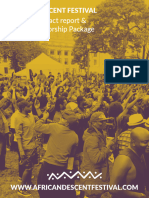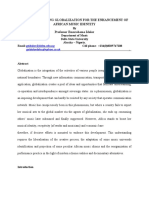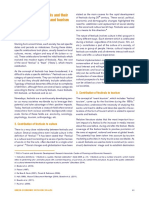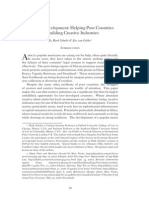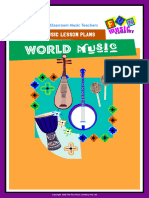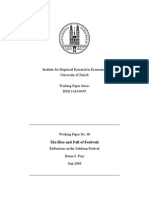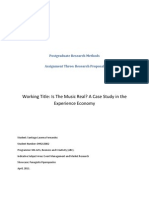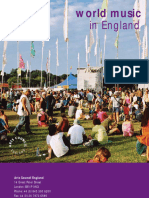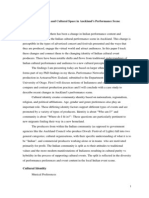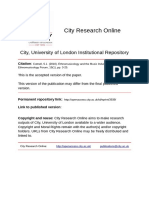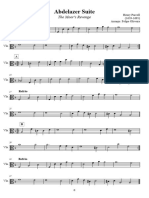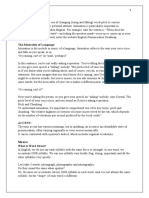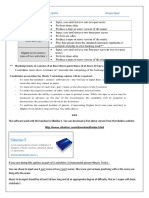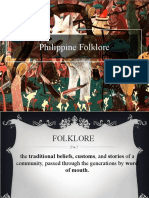ABSTRACT
This study sought to design a new festival brand targeting Ghanaians and Africans in the
diaspora. The objectives of the study were to; (a) understand creative arts branding and its
relevance to African festivals, (b) to analyze industry reports, market trends, and audience
insights to develop a new festival brand, and (c) to create a unique and memorable festival
brand that appeals to the target audience. It has been established that, the creative expressions
of African people are a complex blend of many media, each of which offers a unique
perspective and which together communicates everything from the mundane to the sublime.
The collections of the Library of Congress are particularly strong in information about art,
handicrafts, music, dance, film, oral and written literatures, and other aspects of the
humanities that enrich life in each African community and which have influenced societies
wherever peoples of African descent have settled. Festivals which is subject to the
entertainment industry is increasingly attracting the interest of corporate sponsors, including
telecoms and alcohol brands who are keen to market their products and services to a younger
audience. The global music festivals and event market size was valued at $152.2 billion in
2021 and is projected to reach $481.4 billion by 2031, growing at a Compound Annual
Growth Rate (CAGR) of 9.7% from 2022 to 2031 (HSBC, 2023). “GhanAfriq Music &
ArtsFestival” is a new festival brand and a new multi-disciplined mobile event which will
highlight young and emerging talent of African descent through visual arts, music,
technology, wellness activations while showcasing the diverse culture and history of the Afro
community.
TABLE OF CONTENTS
i
�ABSTRACT...........................................................................................................................................i
INDUSTRY REPORTS AND MARKET TRENDS RELATED TO AFRICAN FESTIVALS............1
CREATIVE ARTS BRANDING AND ITS EFFECTS ON AFRICAN FESTIVALS..........................4
THE NEW FESTIVAL BRAND CONCEPT........................................................................................5
Festival Name:......................................................................................................................................6
Theme: .................................................................................................................................................6
Vision....................................................................................................................................................6
Mission..................................................................................................................................................6
Values....................................................................................................................................................6
Target Audience....................................................................................................................................6
Logo:.....................................................................................................................................................6
Tagline:.................................................................................................................................................6
REFERENCES....................................................................................................................................10
ii
� INTRODUCTION
According to Getz (1991), creative industries are becoming more and more relevant for the
economies of both developed and developing countries. Africa has a comparative advantage
on copyright where enormous potential of folklore and the creativity of African people need
to be fully exploited for socio-economic development and socio-cultural development of a
country. The festivals attract domestic and International tourism as they promote cultural
identity and heritage of the people. During these particular events a lot of activities that create
employment and contribute to the Country’s GDP are experienced (Prentice & Andersen,
2013).
That notwithstanding, the activities of the creative arts industry in the design and branding of
festivals in Africa cannot be overlooked. Popular mention is the “African Diaspora Festival”,
which was announced in 2017. This wonderful event was held in Milton Keynes - England to
celebrate African cultural diversity and promote community cohesion. Simply, the event was
based on celebrating African culture, with three main objectives: (a) Creating pride in youths
for their cultural heritage, (b) Educating others on African culture, (c) Promoting the African
Diaspora Foundation’s amazing charity work, and of course – having fun.
INDUSTRY REPORTS AND MARKET TRENDS RELATED TO AFRICAN
FESTIVALS
A festival is an event ordinarily celebrated by a community and centering on some
characteristic aspects of that community and its religion or tradition which often serve to
fulfill specific communal purposes, especially with regard to commemoration or thanksgiving
(Sally, 2008). The celebrations offer a sense of belonging to religious, social, or geographical
groups, contributing to group cohesiveness. Festivals also provide entertainment, which was
1
�particularly for local communities before the advent of mass produced entertainment.
Festivals that focus on cultural or ethnic topics also seek to inform community members of
their traditions, the involvement of elders sharing stories and experience provide a means for
unity among families (Ogbenika, 2020).
According to Ejikemeuwa (2022), “Africa is the festival continent”. Throughout the whole
continent, colourful and vibrant festivals range through musical, religious, cultural and
harvest to name just a few (Ogbenika, 2020).
With a growing youth population with increasing spending power and a thirst for
entertainment, music incorporated into festivals could play a much bigger role in the
continent’s cultural scene. For instance, each year, at the MTN Bushfire Festival, a multi-
generational crowd of 20,000 people “bring their fire” to the scenic Malkerns Valley of
Eswatini – South Africa, to experience an eclectic pan-African and international line-up of
live music, theatre, poetry, film, dance, and visual arts (Wilks, 2013). The festival model is
being replicated across the continent. South Africa is home to internationally known
celebrations such as the National Arts Festival and the Cape Town Jazz festival which attract
thousands of enthusiasts every year.
In Ghana, the Pan African Historical Festival (PANAFEST) is the most celebrated Pan
African Festival in the world. Inspired back in 1992, by the late great Pan Africanist Efua
Sutherland, PANAFEST has become a landmark festival in Ghana which gives Africans on
the Continent and in the Diaspora a platform to address the most traumatic interruption that
ever occurred in the natural evolution of African societies which among other traumas
profoundly eroded the self-confidence and freedom for self-determination of a whole people
(Akyeampong, 2019).
2
�In East and West Africa, festivals in the economic giants of Kenya and Nigeria cater for a
rising middle class who are prepared to spend an increasing percentage of their disposable
income on events (Prentice & Andersen, 2013).
Meanwhile, North African countries such as Morocco and Tunisia are being marketed as key
music destinations, attracting wealthy European tourists and government patronage. And
outside the obvious locations, successful flagship events take place in the likes of Zimbabwe,
Eswatini and Zanzibar. “The African continent hosts hundreds of annual festivals and cultural
celebrations, though only a small minority target international audiences,” says Yusuf
Mahmoud, Sauti za Busara festival director and chair of Music in Africa Foundation (Enuka,
2019).
The sector is increasingly attracting the interest of corporate sponsors, including telecoms and
alcohol brands who are keen to market their products and services to a younger audience. For
instance, the MTN Bushfire Festival, which has been ongoing for 15 years in Eswatini, is
headlined by the South African telco brand but includes partnerships with up to 70 local and
international sponsors. As Africa emerges from the pandemic and customers return to mass
events, organisers say that sponsors are flocking back to the sector. “After two years, there
was a tremendous appetite from all stakeholders to come back. We managed to sell strong
brands and we have repeat sponsors buying,” says Jiggs Thorne, director of the festival (Adu-
Ampong, 2022).
The global music festivals and event market size was valued at $152.2 billion in 2021 and is
projected to reach $481.4 billion by 2031, growing at a Compound Annual Growth Rate
(CAGR) of 9.7% from 2022 to 2031 (HSBC, 2023).
The outbreak of the COVID-19 pandemic in 2020 negatively impacted the music festivals
and event industry. Almost all the music events and festivals were either canceled or
3
�postponed for indefinite time period. The rapid spread of the COVID disease resulted in
travelling restrictions and lockdown that severely hampered the revenues of the global music
festivals and event market (HSBC, 2023).
According to the music festivals and event market analysis, the market is segmented based on
revenue source, genre, type, age group, gender, and region. The market is divided into tickets,
sponsorships, and others by revenue source. Depending on the genre, it is divided into rock,
pop, EDM, and others. Based on type, it is segregated into music festivals, concerts, shows,
and others. Depending on the age group, the market is segmented below 20 years, 21 to 40
years, and above 40 years. Based on gender, it is segregated into male and female. Region-
wise, it is analysed across North America, Europe, Asia-Pacific, Africa, and LAMEA
(HSBC, 2023).
CREATIVE ARTS BRANDING AND ITS EFFECTS ON AFRICAN FESTIVALS
Walter Landor, one of the greats of the advertising industry, said “simply put, a brand is a
promise. By identifying and authenticating a product or service it delivers a pledge of
satisfaction and quality” (Nelson, 2008). Bates (2013) believes that the best definition is that
a ‘brand is a collection of perceptions in the mind of the consumer’. This definition clearly
distinguishes that a brand is very different from a product or service. A brand is intangible
and exists in the mind of the consumer (Bates, 2013).
The creative expressions of African people are a complex blend of many media, each of
which offers a unique perspective and which together communicates everything from the
mundane to the sublime. The collections of the Library of Congress are particularly strong in
information about art, handicrafts, music, dance, film, oral and written literatures, and other
aspects of the humanities that enrich life in each African community and which have
influenced societies wherever peoples of African descent have settled (Enuka, 2019). Social
4
�media has turned the ways in which the brand interacts with the customer on its head. With
close to 2 billion internet users worldwide, 126 million blogs, 12 billion videos viewed per
month in the US alone, (Thomas, 2021), 2 billion tweets on Twitter per month and 500
million people on Facebook (Crompton, & McKay, 2020), the face of the consumer may
remain essentially the same but the way in which they interact with brands has changed
dramatically.
THE NEW FESTIVAL BRAND CONCEPT
“GhanAfriq Music & Arts Festival” is a new multi-disciplined mobile event which will
highlight young and emerging talent of African descent through visual arts, music,
technology, wellness activations while showcasing the diverse culture and history of the Afro
community. The idea behind this festival concept is based on nationalist visions of an ideal
Africa, the fiction of W. E. B. Du Bois, and Sun Ra’s cosmic mythology of alien abduction
“to portray a future beyond white supremacy, a new black citizen who would inhabit a
world that soars above all existing notions of the possible.” The festival will feature black
utopian artists who through art and paint will project to the world black history and culture.
GhanAfriq Music & Arts Festival is seeking to travel annually to Accra – Ghana and in
partnership with the Ministry of Tourism wishes to activate a once in a lifetime experience
attracting a global audience. The festival will be a 3-days event set to take place on 21st – 24th
December each year, prior to the Christmas festivities. The vision for the GhanAfriq Music &
Arts Festival is a three-day tech and history reality inspired festival that will explore where
technology and design intersects with a focus on the arts, Ghanaian history, African culture,
music, health, technology and political representation. Event curators, honoured guests and
spectators alike will be probed to ask the question “what does a black Utopia look and feel
like”? The event will attempt to answer this question.
5
�Festival Name: “GhanAfriq Music & Arts Festival”
Theme: Projecting black history and culture through tech, art and paint.
Vision
To explore Ghanaian history and culture though art, technology and design with a focus on
the arts, Ghanaian history, African culture, music, health, technology and political
representation.
Mission
To celebrate Ghanaian and African descent through Art, Technology and Design
To showcase black freedom and a future beyond white supremacy
Values
Togetherness
Promote African culture
Strengthen relationships
Educate and enlighten the youth about their culture
Encourage love and sharing among another
Target Audience
The festival targets young artists who can portray the history of Ghana and Africa through
technology, paintings and creative art works.
Logo:
Email: GhanAfriqmusicandartsfest.gh@gmail.com
Tagline: #Unite and celebrate!
Social media pages
Instagram: “GhanAfriqfest” WhatsApp: “+233541824809”
Twitter: @GhanAfriq_musiq&arts_Festival Snapchat: GhanAfriq_fest
Facebook: “GhanAfriq Music&ArtsFestival”
YouTube: “GhanAfriq Music&ArtsFestival”
6
� FESTIVAL THEMES AND ACTIVITIES
Day 1
Christmas is a wonderful time of year, and while it is true that there is no place like home for
the holidays, Ghana allows you to see how much Christmas is cherished there in a special
way. One of the most memorable vacations of a lifetime will be possible on this trip. You
will be greeted at the airport, guided through customs and immigration, and then driven in a
private A/C car to your accommodation in Accra. Arrive at your hotel, unwind, and get ready
for a fantastic evening of delectable food and relaxing music. Place of stay: Ellisa Hospitality
& Spa and Labadi Beach Hotel.
Day 2
Welcome to the thriving metropolis of Accra, which combines both contemporary
architecture and colonial-era buildings. The 120-year-old city provides a distinctive
collection of historical sites, such as the neighborhoods of Jamestown, New Town, and Ga
Mashie. The following visits are scheduled during the day: Drive through Flagstaff House,
the official residence and executive offices of the president (Ghana’s Whitehouse), and visit
the old home of W.E.B. DuBois, which is now a museum and center for the study of
Africanism. Before going to the GhanAfriq festival, aimed to elevate and spotlight the
exciting and blooming millennial talent from and in Africa, we will return to our
accommodation to freshen up. The day will include a joyous celebration of our culture
through live performances, arts and fashion installations, and the finest of African culture.
After your genuinely true African experience, head back to the hotel. Meal(s): Breakfast
Hotel: Location: Labadi Beach Hotel.
7
�Day 3
After a night filled with excitement, have a delectable breakfast at your hotel. We leave about
noon to finish our tour of Accra. Driving past the Independence Square, where Ghana holds
most of its national ceremonies, you will see the enclosed flame of African liberation, which
was lit by Dr. Kwame Nkrumah in 1961. This is where we will stop to visit the Kwame
Nkrumah Memorial Park, the final resting place of Ghana’s first president. The Memorial
Park comprises a museum with pictures, artifacts, and information on Dr. Nkrumah’s life
situated amid lovely grounds. The renowned international market place, the Accra Arts &
Crafts Centre, is just next to the Dr. Kwame Nkrumah Mausoleum.
Consider practicing your negotiating skills while shopping for exquisite real African clothing,
arts, and crafts to give as gifts to family and friends back home at Accra’s largest open
market. The Jamestown district, one of Accra’s most historic communities, where history is
present around every turn, is where the trip for the day comes to a close. The Usher Fort and
lighthouses are its most famous attractions. Enjoy a historical walking tour of Jamestown
while learning about locals’ daily routines. On this Jamestown walking tour, take in the
intriguing sights, sounds, and flavors while tasting some specially chosen street cuisine.
You will have the opportunity to sample and taste a few freshly made local meals such as the
popular Ga Kenkey made from corn dough, fish, red pepper or green sauce, Banku, rice,
eggs, Waakye (made from rice and beans). Enjoy a local buffet with chilled drinks with some
locals.
Afternoon – Lunch. Hotel. Labadi Beach Hotel
2:00pm – 4:00pm – Festivalion of Art, Location: Labadi beach
Meal(s): Dinner. Hotel: Ridge Royal Hotel – Final show: 6:00pm – till day break
8
�The show will be a combination of Ghanaian and African fused music with DJs on rotation to
excite audience with back-to-back hits from genres like Hiplife, Highlife, Afrobeats and the
like. The night will be a display of art works, displaying African history and culture through
painting and visual arts, music, and technology, while showcasing the diverse culture and
history of the Afro community on a giant screen.
9
�REFERENCES
Adu-Ampong, E.A. (2022). “Historical trajectories of tourism development policies and
planning in Ghana, 1957–2017”, Tourism Planning and Development, Vol. 16 No. 2,
pp. 124-141.
Akyeampong, O.A. (2019), “Aboakyer: traditional festival in decline”, Ghana Social Science
Journal, Vol. 16 No. 1, p. 97.
Bates C. (2013). The corporate brand identity matrix. Journal of Brand Management (2013)
20, 742–761. doi:10.1057/bm.2013.12
Birch N. (2011). The Impact of Creative Arts on the Brand, Munich, GRIN Verlag,
https://www.grin.com/document/269676
Crompton, J., and S. McKay (2020). Motives of Visitors Attending Festival Events. Annals of
Tourism Research 24:425–439.
Ejikemeuwa J. O. N. (2022). African Traditional Festivals in a Globalised Society: A
Philosophical Examination of Egba-Eze Ibagwa-aka Community. Accessed online:
https://www.researchgate.net/publication/362225454 Accessed on 19th May, 2023.
Enuka, C., “Globalization and Nigerian Development”. UNIZIK Journal of Arts and
Humanities, vol. VIII, (2019), Pp. 75 – 93.
Getz, D. (1991) Festivals, Special Events and Tourism. New York: Van Nostrand Reinhold.
HSBC (2023). HSBC Holdings Report. Group corporate website | https://www.hsbc.com/.
Accessed online – 24/05/23
Iheanacho, A. O. J., (2014). “Globalizing African Traditional Rituals”. Tansian University
Journal of Arts, Management and Social Sciences, Vol. 1, No. 1,(2014), Pp. 1 – 14.
10
�Lake L. (2021). How Brand Identity Is Defined. Australian Journal of Arts and Humanities,
Vol. 2. Pg. 1-2
Nelson, M.R. (2008). “Doing Good” With Advertising: Building Awareness, Branding, and
Generating Revenue for Social Causes and Non-Profit Organizations. University of
Illinois, Urbana-Champaign, IL Alexandra M. Vilela, Towson University, Towson,
MD
Ogbenika Gregory E. G. (2020). Festivals in Africa and Social Mobilization. International
Journal of Research and Innovation in Social Science (IJRISS) |Volume IV, Issue III,
March 2020|ISSN 2454-6186
Opoku A. A., (1970). Festivals of Ghana, Accra: Ghana Publishing Corporation, pp.1 & ff.
Prentice R. & Andersen V. (2013). Festival as Creative Destination. Annals of Tourism
Research, Vol. 30, No. 1, pp. 7–30.
Sally W. (C.Ed), (2008). Oxford Advanced Learner’s Dictionary, 9th Edition, New York:
Oxford Press.
The Hongkong and Shanghai Banking Corporation (2017). Event and sponsorship. Available
from http://www.hsbcprivatebank.com/en/discover/events-and-sponsorship [Accessed
19 May, 2023]
Thomas van M. (2021). The Effect of Social Media on Society. New Media and Mass
Communication www.iiste.org ISSN 2224-3267 (Paper) ISSN 2224-3275 (Online)
DOI: 10.7176/NMMC
Wilks, L. (2020). The special challenges of marketing the arts festival. In D. O’Reilly, R.
Rentschler and T. Kirchner (Eds.), Routledge companion to arts marketing (pp. 334-
343). Abingdon: Routledge.
11







